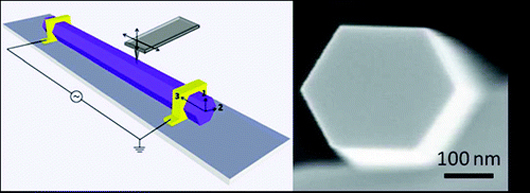- News
9 January 2012
GaN nanowires show six-fold stronger 3D piezoelectric effect than bulk GaN
Although nanowires are often considered one-dimensional (being just 100nm in diameter), researchers at Northwestern University in Evanston, IL, USA have reported that individual gallium nitride (GaN) nanowires show strong piezoelectricity (charge generated by mechanical stress) in three dimensions (published online on 22 December in Nano Letters; DOI: 10.1021/nl204043y).

Graphic: In addition to their direct bandgap, GaN nanowires exhibit piezoelectricity, making them attractive in energy-harvesting applications for self-powered devices.
While GaN is ubiquitous in optoelectronic elements such as blue lasers (i.e. blue-ray disc technology) and LEDs, more recently nanogenerators based on GaN nanowires have been demonstrated that are capable of converting mechanical energy (such as biomechanical motion) to electrical energy.
“Although nanowires are one-dimensional nanostructures, some properties – such as piezoelectricity (the linear form of electro-mechanical coupling) – are three-dimensional in nature,” says Horacio Espinosa (the James N. and Nancy J. Farley professor in Manufacturing and Entrepreneurship at the McCormick School of Engineering and Applied Science). “We thought these nanowires should show piezoelectricity in 3D, and aimed at obtaining all the piezoelectric constants for individual nanowires, similar to the bulk material,” he adds.
The findings revealed that individual GaN nanowires as small as 60nm show piezoelectric behavior in 3D up to six times of their bulk counterpart. Since the generated charge scales linearly with piezoelectric constants, this implies that nanowires are up to six times more efficient in converting mechanical to electrical energy.
To obtain the measurements, researchers applied an electric field in different directions in a single nanowire and measured small displacements, often in the picometer range. The group devised a method based on scanning probe microscopy (SPM) leveraging the high-precision displacement-measurement capability of an atomic force microscope (AFM).
“The measurements were very challenging, since we needed to accurately measure displacements 100 times smaller than the size of the hydrogen atom,” says postdoctoral fellow and lead author Majid Minary.
The researchers say that the results are especially interesting considering the recent demonstration of nanogenerators based on GaN nanowires that are capable of powering self-powered nanodevices.
In addition, they reckon that the method that they have developed is applicable to other piezoelectric nanowire materials as well as wires manufactured along different crystallographic orientations.
http://pubs.acs.org/doi/abs/10.1021/nl204043y
www.mccormick.northwestern.edu
